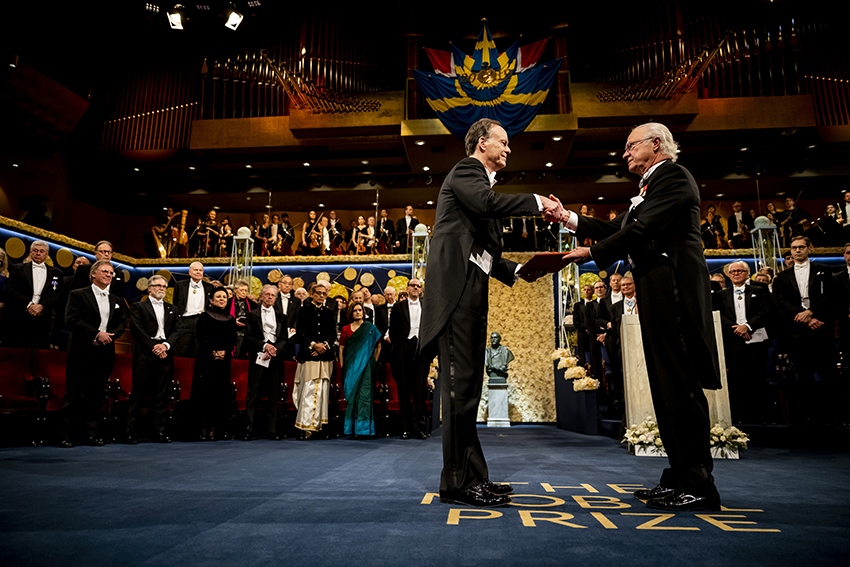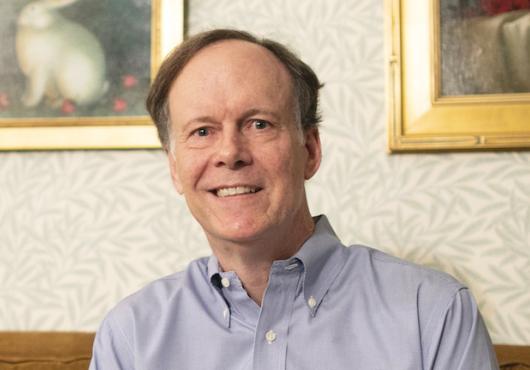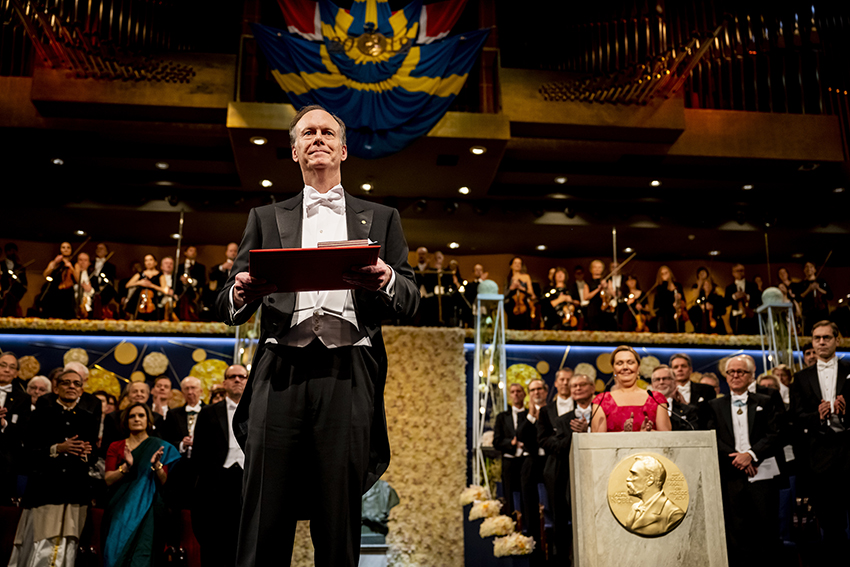
Kaelin at the 2019 Nobel Awards Ceremony. Image: Alexander Mahmoud/© Nobel Media
Last October, William G. Kaelin Jr., the Sidney Farber Professor of Medicine at Harvard Medical School and Dana-Farber Cancer Institute, senior physician in medicine at Brigham and Women’s Hospital and Howard Hughes Medical Institute Investigator, received the highest honor in medicine: the Nobel Prize in Physiology or Medicine.
Kaelin was recognized, together with Peter J. Ratcliffe of the University of Oxford and the Francis Crick Institute and Gregg L. Semenza of the Johns Hopkins University School of Medicine, for his seminal contributions to the discovery of the molecular pathway used by all multicellular organisms to sense and adapt to changes in oxygen levels.
In brief: Kaelin’s research explores how mutations in tumor-suppressor genes can lead to cancer. His early efforts focused on a rare, hereditary syndrome called von Hippel-Lindau disease, caused by defects in the tumor-suppressor gene VHL. By 1996, Kaelin had shown that cells lacking the VHL gene and its associated protein were incapable of sensing oxygen.
Over the next several years, he and others shed light on the function of VHL, including the finding that cells lacking VHL protein were unable to degrade HIF-1-alpha, a protein that is a master regulator of the cellular response to low oxygen levels, and revealed the molecular details of this mechanism.
The months following the announcement were a whirlwind of activity for Kaelin, culminating in the 2019 Nobel Prize award ceremony in Stockholm on Dec. 10.
Kaelin sat down with HM News to talk about those recent experiences, his path to the prize and his thoughts on the landscape of modern bioscience.
HM News: Now that the dust has settled, what’s been your favorite part of the past few months?

Kaelin:
To me, the best part has been sharing in this experience with all of the important people in my life and seeing how much joy and pride it gives them. Whether that’s my family and friends, whether that’s the young people who’ve trained with me, my scientific mentor David Livingston, as well as my many colleagues and collaborators, it’s been just so much fun to share this with them.
HM News: How has your life changed?
Kaelin:
I wasn’t quite prepared for how much changed on that fateful morning, particularly in terms of increased demands on my time to do interviews like this, as well as the degree of celebrity attached to a Nobel. For example, I went on a trip to China and South Korea last fall, and it was probably the closest I’ll ever be to knowing what Mick Jagger feels like. I’m not used to having people ask for my autograph or to take selfies with me. I’m still getting used to it.
I feel a little funny about it because, as I’ve said consistently, there’s some luck involved in this business. There are many, many scientists whose work I admire, who I can point to and say, why not them? So, of course, I’m very thankful and grateful that I got the prize, but I’d rather be thinking about the next experiment, frankly.
HM News: What have you learned from these experiences?
Kaelin:
I think the most important thing is to not let it derail one’s scientific career, to stay focused on one’s work, and to keep things in perspective, which hopefully I’m doing so far. At the same time, I understand that the celebrity can also be put to good use.
In my interviews, I’ve tried to be consistent in championing the importance of investigator-initiated, curiosity-driven basic research, which is the foundation for eventual application. I think it’s very tempting for people to get shortsighted and to think, “Well, we’ll just invest in late-stage and applied science, and we’ll leave basic science on its own.” But that’s not the way science works.
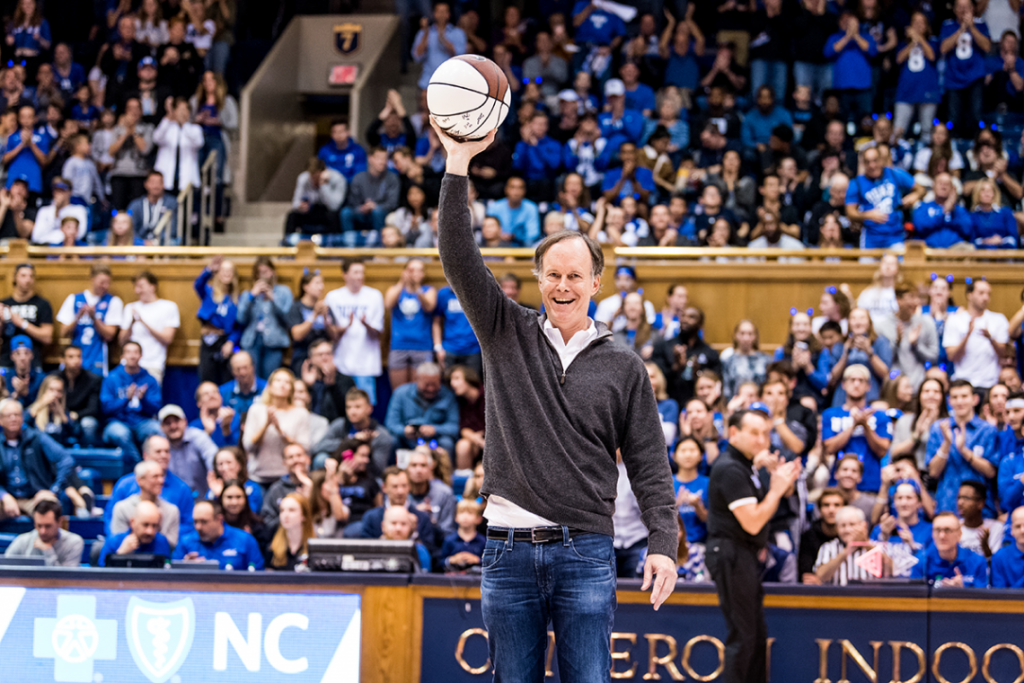
HM News: You’ve been a member of the Harvard community for decades now, but over the years you’ve had many opportunities to put down roots elsewhere. What made you stay?
Kaelin:
I came relatively late to science. I don’t have a PhD. I did all my clinical training before really working in a lab in earnest and, if anything, my first lab experience as an undergrad was pretty awful. It wasn’t until I finished my clinical training here at the Dana-Farber and worked for David Livingston that I really began to think I could do science.

It was clear to me that I still had many, many things to learn, so I wanted to be in an environment where I could continue to grow, where I would have great colleagues and great mentorship which, by the way, doesn’t stop the moment you finish your postdoc. I mean, I still call David once in a while for advice.
I just wanted to be in a place where I could do the best science, and where I would be able to learn from the people around me. I learned many years ago that you grow the fastest when you’re surrounded by people who are smarter and more talented than you are, and who challenge you. I wanted to be in a place where I was distinctly not the smartest person in the room.
Secondly, I think Harvard is one of these places that’s established a positive feedback loop. It’s a great institution because it attracts great young people, and great young people are attracted to it because it’s a great institution. I certainly benefited from a steady stream of bright young people who have really been the ones who made my lab sing over the years.
And if we got drawn into a new area of science, or needed to learn some new technique or new piece of biology, it was usually as easy as grabbing a cup of coffee and walking a few blocks, or, at worst, jumping into a car or onto the T to visit someone else in the greater Boston area.
I considered jobs in industry as well, which was a good exercise because it helps you recalibrate, in terms of thinking about what you like about working in academia versus what do you not like. I came away thinking that I was quite lucky, because I feel like I’m getting paid to play, not paid to work. Even though it’s very stimulating to work at a company, I didn’t have the sense that many people there thought they were playing.
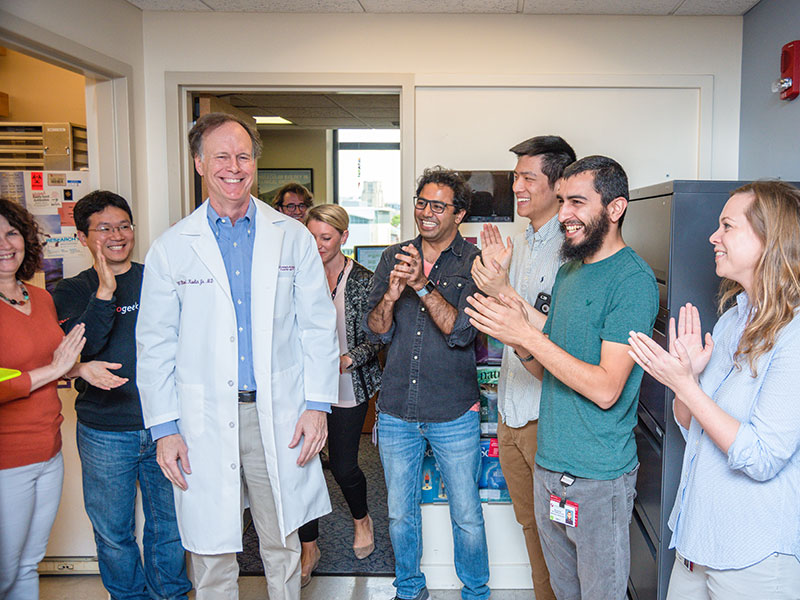
HM News: You’ve been outspoken about the current state of biomedical research and funding. Do you think you could’ve done what you did if you were starting out today?
Kaelin:
I’ve been very lucky over the course of my career, in that every time funding started to get a little tight for me and I started to worry, something came through. I do feel for people today because I think it is tougher, certainly, to get federal funding for basic, curiosity-driven research.
At the same time, that’s been partially offset by the fact that there are more disease-oriented foundations and philanthropic sources than there were when I was younger. There weren’t as many organizations focused on areas like kidney cancer, for example, and we certainly didn’t have the Department of Defense kidney cancer program. I think that’s hopefully softened a little bit of the blow that comes with tighter funding for NIH R01s.
HM News: What would you want to say to lawmakers or other individuals when they ask why tax money should be spent on basic research?
Kaelin:
Well, the first thing I would say is that almost every major breakthrough in applied science can be mapped back to a breakthrough in basic science.
The beauty, as well as the challenge, of basic science is that you can’t always predict what the outcome of the work is going to be. You’re investing in the creation of new knowledge, and the only thing you can be sure of is that the more you invest in basic science, the more new knowledge you will generate. And the more knowledge we have, hopefully, the more improvements we will have in the quality of our lives.
HM News: And the second?
Kaelin:
I think it’s shortsighted to say we’re only going to fund things where you can promise me X in the next five years. Making promises for what you’ll be able to do over a very short timeline is usually not science. It’s usually engineering. I’ve pointed out multiple times that putting a man on the moon was an engineering challenge, which is why Kennedy could say approximately how long and how much money it would take.
But there would’ve been no moonshot if people like Galileo and Newton hadn’t come along and laid down the fundamental science and taught us the necessary scientific principles. I think we have this dynamic, a yin and a yang. We need to invest in both early- and late-stage science, but of the two, it’s the early-stage science that’s most vulnerable.
I would say that what made American science great for most of my life was having this understanding. The public sector, largely the federal government, invests in early-stage science as a form of pump-priming. We then let the private sector be the harvesters who decide when things are ripe for commercialization.
I think that’s been a winning formula for us for decades. As long as we don’t forget it, we will do well, but I think we are in danger of forgetting it. If you look at the Nobel Prizes over the years, there was a dramatic uptick in terms of the number of American Nobel Prizes in the middle of the last century. There are a variety of reasons for that, but one important reason was widespread bipartisan support for science, including basic science, in this country. So, I hope we never get away from that.
